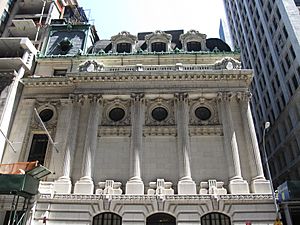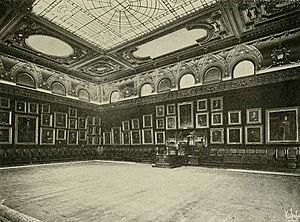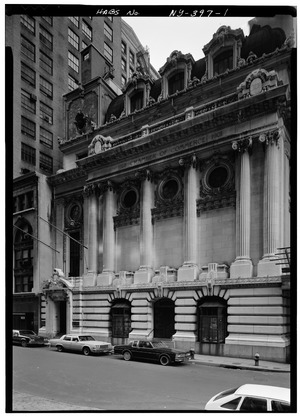Chamber of Commerce Building (Manhattan) facts for kids
|
Chamber of Commerce Building
|
|
|
U.S. Historic district
Contributing property |
|

In 2013
|
|
| Location | 65 Liberty Street Manhattan, New York City |
|---|---|
| Built | 1901–02 |
| Architect | James B. Baker |
| Architectural style | Beaux-Arts |
| Part of | Wall Street Historic District (ID07000063) |
| NRHP reference No. | 73001214 |
Quick facts for kids Significant dates |
|
| Added to NRHP | February 6, 1973 |
| Designated NHL | December 22, 1977 |
The Chamber of Commerce Building is a historic four-story building in New York City. It's located at 65 Liberty Street in the Financial District of Manhattan. Designed by architect James Barnes Baker, it was built between 1901 and 1902. This building was special because it was the first one made specifically for the Chamber of Commerce of the State of New York.
The building is covered in beautiful Vermont marble. It has a rough-looking stone base, a row of columns, and a special copper roof called a mansard roof. In the past, there were statues of important figures like John Jay, Alexander Hamilton, and DeWitt Clinton on the outside. These were created by famous artists Daniel Chester French and Philip Martiny. Inside, the second floor held the Chamber of Commerce's "Great Hall." This large room was decorated with portraits of important people from American history. Other parts of the building were used for offices and meeting rooms. Over the years, many shops and banks have rented space on the ground floor. When it was finished, people really liked the building's design.
The building was built with money raised by wealthy members of the Chamber of Commerce. Later, in 1922, architects Helmle and Corbett updated the inside and added a new floor, which changed the mansard roof. The statues by French and Martiny had to be removed in 1926 because they were getting old and damaged. The Chamber of Commerce moved to Midtown Manhattan in 1979. After that, the building was empty for ten years. In 1989, the International Commercial Bank of China bought the building. They had the inside renovated by Haines Lundberg Waehler.
The Chamber of Commerce Building was praised for its design and size when it was new. It was named a city landmark by the New York City Landmarks Preservation Commission in 1966. It was also added to the National Register of Historic Places (NRHP) in 1973. In 1977, it became a National Historic Landmark. Today, it is part of the Wall Street Historic District, which is a historic area listed on the NRHP since 2007.
Contents
Where is the Building Located?
The Chamber of Commerce Building is in the Financial District of Manhattan. It sits on the southeast corner of a city block. This block is bordered by Broadway to the west, Liberty Street to the south, Liberty Place to the east, and Maiden Lane to the north. Liberty Place is a small alley between the Chamber of Commerce Building and the Liberty Tower.
The building's property covers about 7,878 square feet. It has a front side of about 83 feet on Liberty Street and goes back about 91 feet. Many other buildings surround it. These include the Liberty Tower and the Federal Reserve Bank of New York Building to the east. Also nearby are 28 Liberty Street to the southeast, 140 Broadway to the south, and One Liberty Plaza to the west.
What Does the Building Look Like?
The Chamber of Commerce Building was designed in the Beaux-Arts style. This style is known for being grand and classical. The architect was James Barnes Baker, who was also a member of the Chamber of Commerce of the State of New York. The building was expanded in 1922 by Helmle & Corbett. The inside was updated again in 1991 by Haines Lundberg Waehler. Charles T. Wills was the main builder for both the original work and the 1922 expansion.
The building has four main stories and a smaller attic story. Its walls are made of strong masonry, which helps support the building. The total inside area is about 30,681 square feet.
The Outside (Facade)
The outside of the building is made of Vermont marble. The bottom part has rough-cut blocks of stone, which is called rusticated masonry. The top story is hidden inside a mansard roof covered with copper. The front of the building on Liberty Street has four vertical sections, called bays. It is also divided into three horizontal parts: the ground floor, the second floor, and the third and fourth floors. The bay on the far left of Liberty Street is more decorated than the others. The side of the building on Liberty Place looks similar but is simpler, with five bays.
There are two entrances on the ground floor of Liberty Street. Both are a little above street level. The entrance to the ground floor is in the second bay from the right. It has a rounded arch and two tall windows on either side. A more fancy entrance to the upper floors sticks out a bit from the leftmost bay. This left entrance has an arched top with detailed carvings. Above this entrance, there used to be a carving by Karl Bitter. It showed Ceres and Mercury, who were Roman gods representing trade. A carved marble band runs just above the ground floor.
On the second floor, the three bays on the right side of Liberty Street have a small colonnade. This is a row of six tall, fluted columns with Ionic-style tops. There are two columns at each end and two single columns in the middle. Inside this colonnade, there used to be three large sculptures on pedestals. Each sculpture was 8 feet tall. They showed DeWitt Clinton (by Daniel Chester French) and John Jay and Alexander Hamilton (by Philip Martiny). Near the top of the colonnade are oval windows. These windows look into what was the Chamber of Commerce's main room. They have decorative supports and carvings of wreaths and swags. Above the colonnade is a decorative band with small blocks and teeth-like carvings. The leftmost bay on Liberty Street is not part of the colonnade. It has an oval window above a large rectangular window. The Liberty Place side also has similar oval windows at the top.
The third and fourth floors were originally set back from the Liberty Street facade. This created a terrace above the colonnade. The third floor is simply decorated with pairs of windows in each section. The fourth floor is inside the dormer roof. The mansard roof has three dormer windows facing Liberty Street and three facing Liberty Place. These windows have decorative tops and spiral shapes on their sides.
Inside the Building
When the building was first designed, the main entrance led to a large lobby. This lobby then opened into a tall hall, about 20 by 80 feet. This hall was made of Caen stone and marble. The building's elevators and a staircase to the second-floor Great Hall were at the end of this hall. The staircase was inspired by the Ducal Palace in Venice. It led to the main room on the second floor and the elevator area. The upper part of the hall was very fancy. It had colored marble columns supporting a decorative band, and a domed ceiling above. Between the columns, there were tablets with the names of the Chamber of Commerce's leaders. The rest of the ground floor was rented out as a banking room. This was the only commercial part of the building.
In general, the upper floors had decorative wood and marble work. The third and fourth floors had meeting rooms and space for the Commerce Club. This part of the building included the library, the president's room, committee rooms, and offices. Much of the furniture was in a colonial style. The president's room was more decorated than the other rooms. After the 1922 renovation, the fourth floor had an oak-paneled elevator area and a vaulted stair hall. The ceiling of the fourth-floor elevator area had three eight-sided carvings. These carvings showed ideas like trade, industry, and transportation. The original library on the fourth floor became a banquet room. A new story with a library and committee rooms was also added. During the 1991 renovation, the third and fourth floors became executive offices for the International Commercial Bank of China. The top story became a cafeteria.
The Great Hall
The Great Hall was the building's main room, located on the second floor. It was about 90 by 60 feet, with a ceiling 30 feet high. The lower part of the room had no windows because the Chamber's many large portraits were meant to hang there. The upper part of the room, above 20 feet, had the oval windows seen from the outside. The walls were topped with colorful decorations like cartouches, wreaths, swags, and horns. A skylight was in the center of the ceiling, surrounded by a gilded, curved ceiling.
At its busiest, there were almost 300 portraits in the room. These included paintings of John Cruger, the first president of the Chamber, Alexander Hamilton, a Founding Father of the United States, and Ulysses S. Grant, a former president of the United States. The paintings dated back to 1772. They were usually only of people who had passed away. The Chamber never removed portraits once they were hung. The collection was mostly for Chamber members to see, but the public was sometimes allowed inside. Many portraits were removed when the Chamber moved out in 1979. The collection was split up, with some portraits being given away or sold.
The floor had a "large and beautiful rug" that covered almost the entire space. This custom carpet was about 59.67 by 37.67 feet and weighed 2,750 pounds. It was so big that it had to be delivered in a special crate. Part of the building's outer wall had to be temporarily removed to get the carpet inside. The original floor was made of marble. However, it was covered with a plywood platform in 1991. When the Chamber of Commerce used the building, seats were arranged along the walls. In the center of one wall, a raised platform held the President's chair and desk, along with desks for other officials. In 1991, after the renovation, mahogany desks for the International Commercial Bank of China were installed.
History of the Building
The Chamber of Commerce of the State of New York was started in 1768. It was the first organization of its kind in North America. After King George III gave the Chamber a formal charter in 1770, they held their first meeting at the Fraunces Tavern. Twenty merchants attended this meeting. Before the Chamber of Commerce Building was constructed, the Chamber had moved into the Real Estate Exchange Building at 65 Liberty Street in 1884. This building was a six-story structure with an iron front. However, the Chamber had never had a building built just for its headquarters until the current one.
How the Building Was Planned and Built
By the late 1800s, the Chamber of Commerce wanted to build a new headquarters. They needed more space for offices and a large meeting room. Architectural Record magazine said the Chamber wanted its meeting hall to be "spacious and imposing." They also wanted the outside of the building to be "large enough to avoid insignificance." At that time, the Chamber was in a "small apartment." While their monthly meetings were small, their annual luncheons brought hundreds of members. Their old space could only fit fifty people.
A fund to build a new Chamber of Commerce building started in early 1897. By June of that year, they had raised $450,000, aiming for $1 million. By April 1900, they had raised the full $1 million. Wealthy members of the Chamber eventually raised a total of $1.5 million. Some of the people who donated included Andrew Carnegie, J. P. Morgan, John D. Rockefeller, Cornelius Vanderbilt III, William Collins Whitney, and the Guggenheim family. The Chamber's president, Morris K. Jesup, bought the Real Estate Exchange Building in January 1901 for $700,000. James B. Baker was chosen as the architect by May of that year. The cornerstone of the new building was laid on November 8, 1901. Over a hundred Chamber members attended the ceremony.
In May 1902, Chamber members Morris Ketchum Jesup, John Stewart Kennedy, and William E. Dodge donated the statues of DeWitt Clinton, Alexander Hamilton, and John Jay. These sculptures were to cost $12,000 each. Martiny and French were hired to create them. The Chamber of Commerce Building officially opened on November 11, 1902, just over a year after the cornerstone ceremony. Former U.S. president Grover Cleveland gave the main speech. Guests included then-current U.S. president Theodore Roosevelt and representatives from other countries. The sculptures by Martiny and French were officially dedicated on November 17, 1903, with 400 Chamber members present.
The Chamber of Commerce Uses the Building
In the early 1900s, the Lawyers' Title Insurance and Trust Company had offices in the Chamber of Commerce Building. They had 700 employees. The company moved to its own building between July and September 1908. The Lawyers' Mortgage Company used the basement and ground floor from 1906 until 1921. Then, the Guaranty Trust Company leased that space. After World War I, the Chamber of Commerce's importance began to decrease as large corporations became more powerful. In June 1921, the building was temporarily closed for renovations. Architects Helmle and Corbett remodeled the interior. As part of this project, the mansard roof was changed to add a full story. This new floor housed the Chamber's library and two committee rooms. A dining room was added on the third floor. A new elevator lobby and emergency stairway were also added. The expanded building reopened on January 5, 1922.
The sculptures on the outside of the building became very worn down by weather and chemical reactions. They were removed in 1926. The Piccirilli Brothers made copies of the sculptures. This was in case the Chamber ever wanted to replace them with granite or bronze versions, but this never happened. In the same year, the Interstate Trust Company opened in the ground floor and basement after changes were made to these areas. The Harriman National Bank occupied the ground-floor space by 1929. Harriman only stayed in the building until the mid-1930s. The Chamber of Commerce was generally slow to use new technology. For example, in 1927, they chose to replace the building's old light dimmers instead of buying a newer lighting system.
The ground floor and basement were leased to the Wanamaker's department store in 1944. This space was used for Wanamaker's men's division. After World War II, most of the Chamber's daily work was handled by outside groups. The Chamber became an organization run mostly by volunteers. Because of this, the Great Hall was not used as often. In 1968, the general public was allowed to regularly enter the Great Hall for the first time. The New York Chamber of Commerce merged with the Commerce and Industry Association in 1973. The building at 65 Liberty Street then became the headquarters for the Chamber of Commerce and Industry.
What Happened Later
The Chamber decided to sell 65 Liberty Street in 1979. They moved to 200 Madison Avenue in Midtown Manhattan. They also merged with the New York City Partnership to create the Partnership for New York City. When they moved, the portraits from the Great Hall also had to be removed. The new offices could only fit 10 to 20 of the Great Hall's 300 portraits. However, the Chamber of Commerce Building could store about 200 of them. There was a disagreement about removing the portraits. Art experts felt they were a key part of the room's history. About 80 portraits would have to be given away. The Chamber's collections curator, Evelyn G. Ortner, said in early 1983 that the Chamber was no longer selling portraits. Some of these portraits were later shown at the New-York Historical Society.
The Chamber of Commerce Building was empty for ten years. This was because potential renters found it too expensive to update to modern standards. Also, potential buyers had twice failed to complete the sale. In 1989, the International Commercial Bank of China (now Mega International Commercial Bank) bought the building for $5.75 million. Two years later, Haines Lundberg Waehler finished renovating the building into office space. This cost more than $12 million. The badly damaged wall coverings were replaced with velvet. A plywood floor was laid over the original marble floor of the Great Hall, and cables were run underneath it. The building's mechanical systems were also completely updated. Since the building was on the National Register of Historic Places (NRHP) and was a New York City designated landmark, the bank hoped to get a tax credit for the renovation. As of 2021, Mega International still owns the building.
Images for kids
See also
 In Spanish: Chamber of Commerce Building (Nueva York) para niños
In Spanish: Chamber of Commerce Building (Nueva York) para niños





